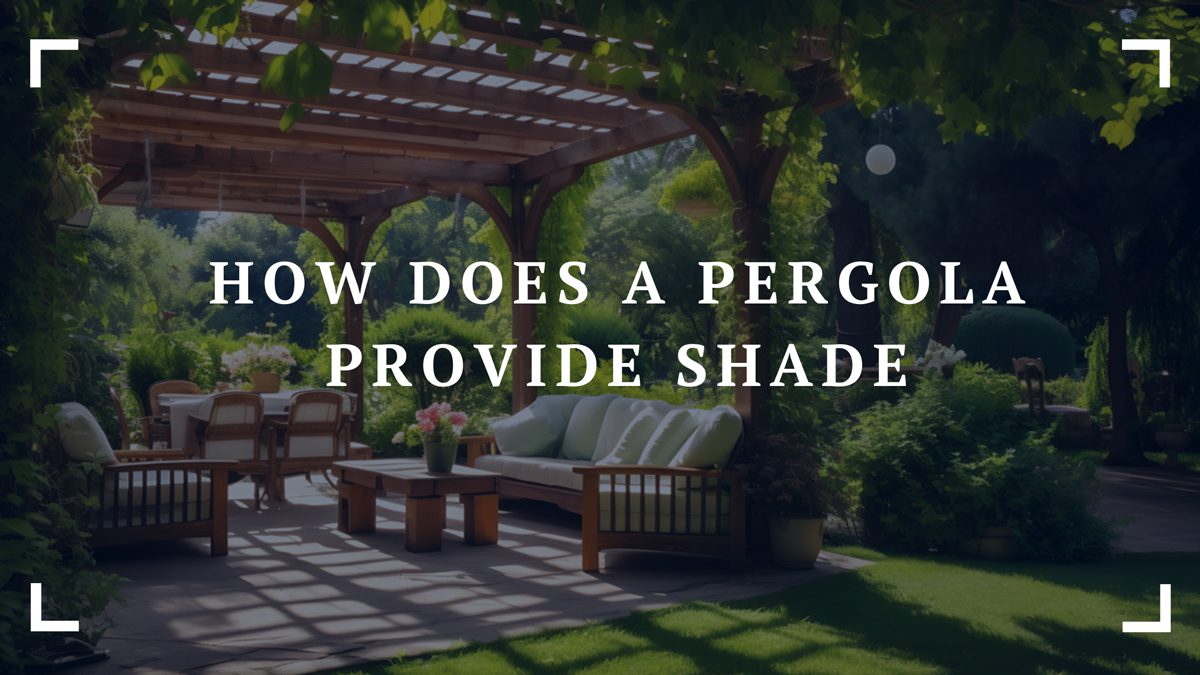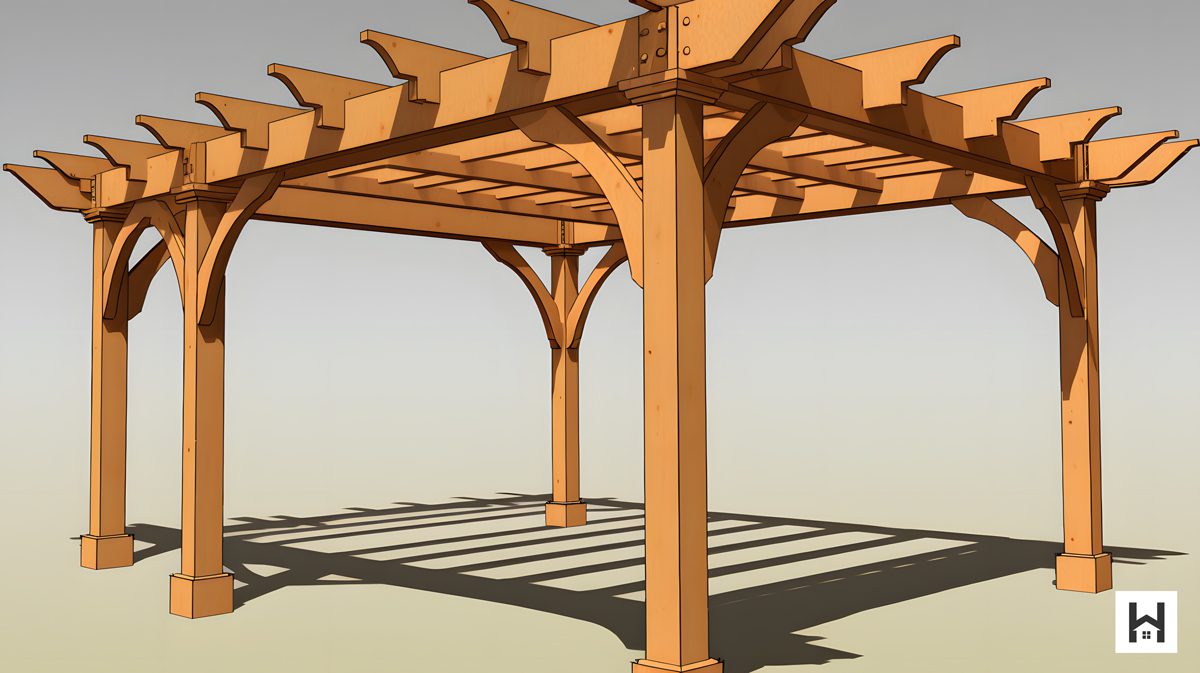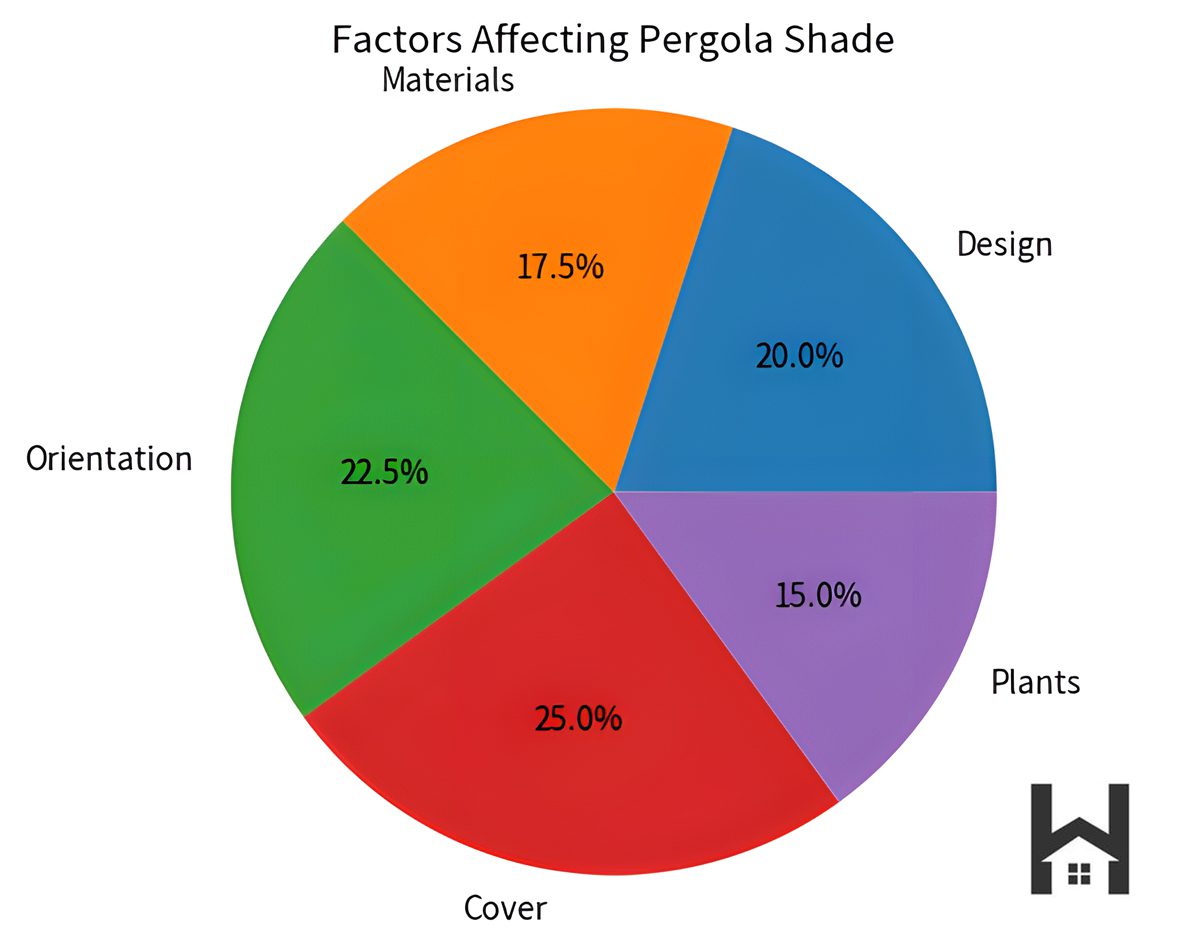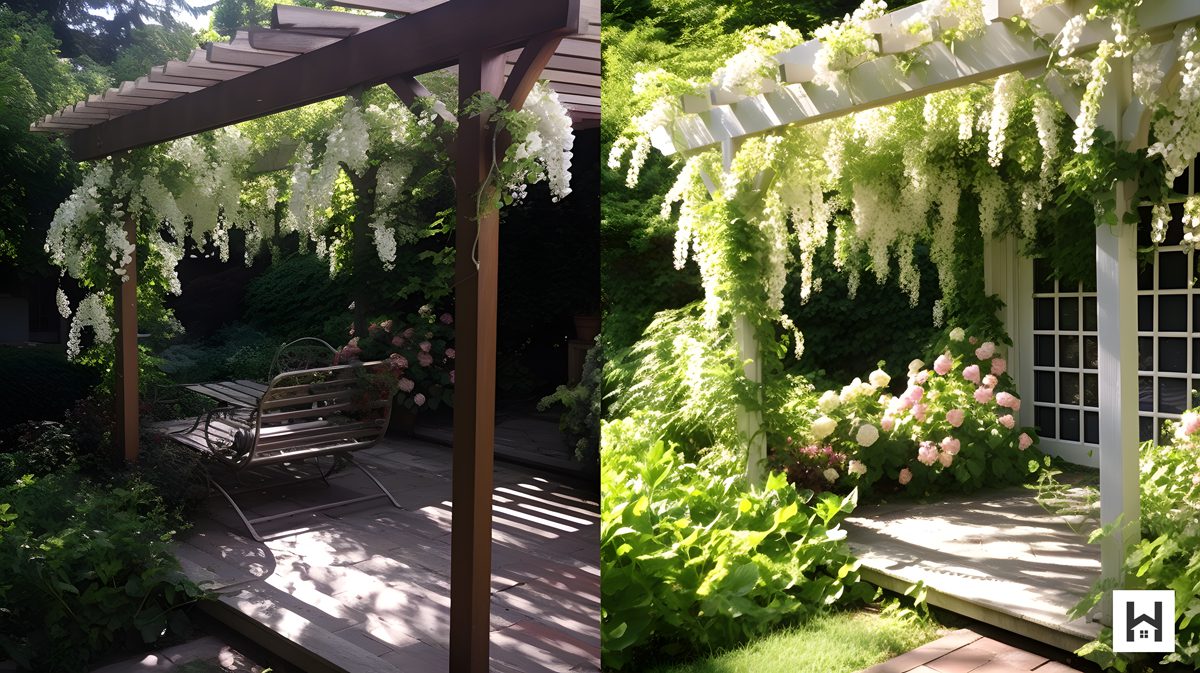Imagine a sunny afternoon, the heat is intense, and all you want is to enjoy your outdoor space without the scorching sun ruining your relaxation.
Enter the pergola, your personal oasis of shade and beauty.
But how does a pergola provide shade, and how can you maximize its benefits?
In this comprehensive guide, we’ll explore everything you need to know about pergolas and their role in providing shade.
So, grab a cool drink, find a comfy spot, and let’s dive in!
Key Takeaways
- Pergolas are outdoor structures that provide shade and enhance the aesthetic appeal of your outdoor space.
- The amount of shade a pergola provides depends on its design, orientation, materials used, and the presence of a cover or climbing plants.
- The orientation of a pergola can significantly impact the amount of shade it provides. A north-south oriented pergola provides changing shade patterns, while an east-west orientation provides consistent shade on one side.
- Different materials used in pergola construction can affect the amount of shade and the durability of the structure. Wood, metal, and vinyl are common choices.
- Pergola covers and climbing plants can provide additional shade. There are various types of covers available, and certain plants are more suited for growing on pergolas.
- Regular maintenance of your pergola can ensure it continues to provide optimal shade and prolong its lifespan.
Table of Contents
- Key Takeaways
- What is a Pergola?
- Understanding the Structure of a Pergola
- How Does a Pergola Provide Shade?
- Materials Used in Pergola Construction
- The Role of Pergola Covers in Providing Shade
- Incorporating Plants for Additional Shade
- Maintaining Your Pergola for Optimal Shade
- Pergola Design Ideas for Maximum Shade
- FAQ
- Conclusion

What is a Pergola?
Before we delve into the nitty-gritty, let’s start with the basics. What exactly is a pergola?
A pergola is an outdoor structure, often found in gardens or patios, that typically consists of vertical posts supporting an open roof of beams and rafters. Unlike a gazebo, which is enclosed, a pergola is open on all sides. The roof, while not completely solid, provides a certain level of shade, making it a perfect place to relax on a sunny day.
The History and Evolution of Pergolas
Pergolas have a rich history that dates back to ancient times. They were originally used in the Mediterranean regions to provide a shaded pathway in a garden or a link between pavilions. The early pergolas were often made of stone pillars and wooden cross-beams with a lattice.
Over time, pergolas have evolved and adapted to different cultures, climates, and architectural styles. Today, they come in a variety of shapes, sizes, and materials, including wood, metal, and vinyl. Despite these changes, the core function of a pergola remains the same – to provide a relaxing outdoor space with a balance of sun and shade.
Understanding the Structure of a Pergola
Now that we’ve covered what a pergola is and its historical background, let’s delve into the structure of a pergola. Understanding the structure is key to comprehending how a pergola provides shade.

Key Components of a Pergola
A pergola is made up of several key components:
- Posts: These are the vertical structures that support the pergola. They act as the legs of the pergola, holding up the weight of the cross-beams and rafters.
- Cross-beams: These are the horizontal structures that are attached to the top of the posts. They provide the framework for the rafters.
- Rafters: These are the series of beams that are laid across the cross-beams. They are usually spaced apart to allow sunlight to filter through, creating a balance of sun and shade.
- Lattice (optional): Some pergolas have a lattice structure added on top of the rafters for additional shade or to support climbing plants.
Different Types of Pergolas and Their Unique Features
Pergolas come in a variety of types, each with its unique features. Here are a few common types:
- Gable Pergolas: These pergolas have a pitched roof, which allows rainwater to run off easily. The open structure still allows sunlight to filter through.
- Flat Roof Pergolas: As the name suggests, these pergolas have a flat roof. The rafters are laid out in a grid pattern, providing more shade than a gable pergola.
- Open-Top Pergolas: These pergolas have widely spaced rafters, allowing more sunlight to filter through. They are ideal for areas where you want more sun than shade.
- Sail Pergolas: These pergolas use a stretched fabric instead of traditional rafters to provide shade. They are modern and stylish, offering a unique aesthetic to your outdoor space.
How Does a Pergola Provide Shade?
Now that we’ve explored the structure of a pergola, let’s dive into the heart of the matter – how does a pergola provide shade? The answer lies in the design of the pergola and its orientation.

The Role of Pergola Design in Providing Shade
The design of a pergola plays a significant role in the amount of shade it provides. The key elements that influence this are the spacing of the rafters and the addition of a lattice or canopy.
- Rafters: The rafters are the primary source of shade in a pergola. The closer the rafters are spaced, the more shade the pergola will provide. Conversely, if the rafters are spaced further apart, more sunlight will filter through.
- Lattice or Canopy: Adding a lattice on top of the rafters or installing a retractable canopy can significantly increase the amount of shade a pergola provides. A lattice can support climbing plants, which, over time, can create a beautiful, natural canopy. A retractable canopy, on the other hand, gives you the flexibility to control the amount of sun or shade.
The Impact of Pergola Orientation and Location on Shade
| Factor | Description |
|---|---|
| Design | The design of a pergola, including the number and spacing of the slats or rafters, affects the amount of shade it provides. |
| Materials | The materials used in the construction of a pergola can affect its durability and the amount of shade it provides. |
| Orientation | The orientation of a pergola can affect the pattern and amount of shade it provides throughout the day. |
| Cover | Adding a cover to a pergola can increase the amount of shade it provides. |
| Plants | Climbing plants or vines can provide additional shade and enhance the aesthetic appeal of a pergola. |
The orientation and location of your pergola also impact the amount of shade it provides. Here’s how:
- Orientation: The direction your pergola faces can affect the movement of shadows as the sun moves across the sky. For example, a north-facing pergola (in the northern hemisphere) will have the sun behind it for most of the day, providing more shade.
- Location: The location of your pergola in relation to your house and surrounding landscape can also influence its shade. For instance, if your pergola is located near tall trees or buildings that cast shadows, it may receive more shade.
Materials Used in Pergola Construction
The material you choose for your pergola not only affects its appearance but also its functionality in terms of providing shade and its overall durability. Let’s explore some of the common materials used in pergola construction and how they impact these aspects.

Common Materials Used in Pergola Construction
Pergolas can be constructed from a variety of materials, each with its unique characteristics. Here are a few common ones:
- Wood: Wood is a popular choice for pergolas due to its natural beauty and versatility. Types of wood used can range from pressure-treated softwoods to more durable hardwoods.
- Vinyl: Vinyl pergolas are virtually maintenance-free and resist rot and insects. They are typically white, which can help reflect sunlight and provide more shade.
- Metal: Metal pergolas, often made from steel or aluminum, are sturdy and durable. They can be painted any color, allowing for customization to match your outdoor decor.
- Fiberglass: Fiberglass pergolas are lightweight, strong, and can be molded into many shapes and styles. They are often white, which can help increase shade.
How Material Choice Affects Shade and Durability
The material of your pergola can influence the amount of shade it provides and its longevity. Here’s how:
- Shade: Light-colored materials like white vinyl or fiberglass can reflect more sunlight, potentially providing more shade. The thickness and design of the material can also affect the amount of sunlight that filters through.
- Durability: The durability of your pergola is crucial for its longevity. Materials like metal and vinyl are more durable and resistant to weather elements compared to wood, which may require more maintenance to prevent rot and insect damage.
Choosing the right material for your pergola is a balance between aesthetics, the amount of shade you desire, and the level of maintenance you’re willing to undertake.
The Role of Pergola Covers in Providing Shade
While the structure and material of a pergola play a significant role in providing shade, you can enhance this further with the use of pergola covers. Let’s delve into the different types of pergola covers and how to choose the right one for maximum shade.

Different Types of Pergola Covers
There are several types of pergola covers available, each offering varying degrees of shade and protection from the elements. Here are a few common ones:
- Fabric Canopies: These are often made from durable, weather-resistant fabric and can be either fixed or retractable. They provide excellent shade and can be easily removed or retracted when not needed.
- Lattice Covers: These are typically made from wood or vinyl and provide partial shade while still allowing some sunlight to filter through.
- Solid Roof Covers: These are made from various materials like metal, polycarbonate, or even glass. They provide the most shade and protection from the elements but can block out sunlight completely.
- Climbing Plants: While not a traditional cover, climbing plants like vines can be grown over the pergola to provide a natural, beautiful canopy of shade.
How to Choose the Right Pergola Cover for Maximum Shade
Choosing the right pergola cover depends on several factors:
- Amount of Shade Desired: If you want maximum shade, a solid roof cover or a dense fabric canopy would be ideal. If you prefer partial shade, a lattice cover or climbing plants might be more suitable.
- Weather Conditions: If your area experiences heavy rain or snow, a solid roof cover would provide better protection. For milder climates, a fabric canopy or lattice cover would suffice.
- Aesthetics: The cover should complement the style of your pergola and overall outdoor decor. For a natural look, climbing plants are a great option.
- Maintenance: Consider the maintenance requirements of the cover. Fabric canopies may need to be cleaned regularly, while solid roof covers may require less upkeep.
By considering these factors, you can choose a pergola cover that not only enhances the shade but also adds to the beauty and functionality of your pergola.
Incorporating Plants for Additional Shade
One of the most natural and aesthetically pleasing ways to increase the shade provided by your pergola is by incorporating plants. Let’s explore the best plants for pergolas and how they enhance both shade and aesthetics.

Best Plants for Pergolas
When it comes to choosing plants for your pergola, consider climbing plants that can grow over the structure to form a lush, green canopy. Here are a few options:
- Wisteria: Known for its beautiful, fragrant flowers, wisteria is a fast-growing vine that can quickly cover your pergola, providing ample shade.
- Climbing Roses: Climbing roses can add a romantic touch to your pergola. They grow vertically and can cover a pergola with a blanket of roses.
- Grape Vines: If you’re looking for a practical and aesthetic option, grape vines are a great choice. They provide shade, and you get the bonus of fresh grapes!
- Clematis: Clematis is a versatile climbing plant that comes in many varieties and colors. It’s a great choice for adding a splash of color to your pergola.
- Ivy: Ivy is a classic choice for a pergola. It’s hardy, fast-growing, and provides a dense cover of foliage for shade.
How Plants Enhance Shade and Aesthetics of Pergolas
Incorporating plants into your pergola design has several benefits:
- Increased Shade: Climbing plants can form a dense canopy over your pergola, providing additional shade and reducing the amount of sunlight that filters through.
- Natural Beauty: Plants add a touch of natural beauty to your pergola, transforming it into a lush, green oasis. The flowers or fruits that some plants produce can also add color and interest to your outdoor space.
- Cooling Effect: Plants can help to cool the area under your pergola. Through a process called transpiration, plants release moisture into the air, which can help to lower the temperature.
- Privacy: A dense cover of plants can provide a sense of privacy, making your pergola feel like a secluded retreat.
By carefully selecting and incorporating plants into your pergola design, you can enhance both the shade and the aesthetic appeal of your outdoor space.
Maintaining Your Pergola for Optimal Shade
To ensure your pergola continues to provide optimal shade and remains an attractive feature in your outdoor space, regular maintenance is essential. Let’s explore the maintenance tasks for pergolas and some tips for prolonging their life.
Regular Maintenance Tasks for Pergolas
The maintenance tasks for your pergola will depend on the material it’s made from and whether you have plants growing on it. Here are some general tasks:
- Cleaning: Regularly clean your pergola to remove dirt, bird droppings, and other debris. For most materials, a gentle wash with soapy water and a soft brush will do the trick.
- Inspection: Regularly inspect your pergola for signs of damage or wear. Check for loose screws, cracks, rot (for wooden pergolas), or rust (for metal pergolas).
- Painting or Staining: If your pergola is made from wood, it may need to be repainted or restained every few years to protect it from the elements and keep it looking its best.
- Pruning: If you have plants growing on your pergola, regular pruning will keep them healthy and prevent them from overgrowing and damaging the structure.
Tips for Prolonging the Life of Your Pergola
Here are some tips to help prolong the life of your pergola:
- Choose Durable Materials: If you’re in the planning stages, choose materials known for their durability and resistance to weather elements.
- Use Protective Coatings: Protective coatings can help to shield your pergola from the elements. This is particularly useful for wooden pergolas.
- Install a Cover: Installing a cover can protect your pergola from harsh weather conditions, prolonging its life.
- Regular Maintenance: Regular maintenance is key. By promptly addressing any issues, you can prevent minor problems from becoming major ones.
By maintaining your pergola and taking steps to prolong its life, you can ensure it continues to provide shade and enhance your outdoor space for many years to come.
Pergola Design Ideas for Maximum Shade
Innovative pergola designs can not only enhance the aesthetic appeal of your outdoor space but also provide more shade. Let’s explore some design ideas and case studies of effective pergola designs.
Innovative Pergola Designs for More Shade
Here are some innovative pergola design ideas that can provide more shade:
- Slatted Roofs: A pergola with a slatted roof can provide more shade than traditional designs. The slats can be adjusted to control the amount of sunlight that filters through.
- Layered Roofs: A layered roof design involves having multiple layers of rafters or slats. This can create a denser roof that provides more shade.
- Extended Rafters: Extending the rafters beyond the posts can create a larger shaded area under the pergola.
- Multi-Level Pergolas: A multi-level pergola can provide varying levels of shade, allowing you to choose the level of sunlight you want at any given time.
Case Studies of Effective Pergola Designs
Let’s look at a couple of case studies where innovative pergola designs have been used to create more shade:
- Case Study 1: A homeowner in a sunny locale opted for a pergola with a retractable canopy. This design allowed them to adjust the amount of shade throughout the day, providing maximum shade during the peak sun hours.
- Case Study 2: A restaurant with an outdoor seating area used a multi-level pergola design. The different levels provided varying amounts of shade, allowing patrons to choose their preferred seating area based on their comfort level with sunlight.
These design ideas and case studies illustrate how you can get creative with your pergola design to maximize shade.
FAQ
Can I use a pergola as a permanent shade structure?
While pergolas can provide some shade, they are not designed to completely block out the sun. The amount of shade a pergola provides depends on its design and the materials used. For more shade, consider adding a cover or growing climbing plants on your pergola.
What types of covers can I use for my pergola?
There are various types of pergola covers available, including retractable canopies, shade cloths, and even outdoor fabric. The choice depends on your personal preference, budget, and the level of shade you desire.
How does the orientation of a pergola affect the shade it provides?
The orientation of your pergola can significantly impact the amount of shade it provides. A pergola oriented north-south will provide changing shade patterns throughout the day, while an east-west orientation will give consistent shade on one side.
Can I grow plants on my pergola for additional shade?
Yes, growing climbing plants or vines on your pergola is a great way to increase shade. Some popular choices include wisteria, grapevines, and climbing roses. However, keep in mind that plants will require regular care and maintenance.
How does the material of a pergola affect its shade and durability?
The material of a pergola can significantly impact both the shade it provides and its longevity. For instance, wooden pergolas may offer more shade but require regular maintenance to prevent rot and insect damage. On the other hand, metal or vinyl pergolas may be more durable but provide less shade.
Conclusion
Pergolas are more than just a beautiful addition to your outdoor space. They provide valuable shade, making your outdoor areas more comfortable and usable even in the heat of the day. With the right design, materials, and maintenance, your pergola can serve as a functional and attractive feature in your outdoor living space for years to come.
Feeling inspired to start your pergola project? Go ahead! Remember, the key to a great pergola is in the planning. Consider the amount of shade you want, the style that suits your outdoor decor, and the level of maintenance you’re ready to undertake.
Already have a pergola? We’d love to hear your story! Share your experiences, tips, and photos with us. Your insights could inspire others on their pergola journey.


